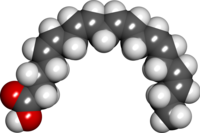
Photo from wikipedia
This study aimed to develop a bioprocess using plant oil as the carbon source for lipid-assimilating yeast to produce high-value astaxanthin. Using high-oleic safflower oil as a model, efficient cell… Click to show full abstract
This study aimed to develop a bioprocess using plant oil as the carbon source for lipid-assimilating yeast to produce high-value astaxanthin. Using high-oleic safflower oil as a model, efficient cell growth and astaxanthin production by the engineered Yarrowia lipolytica strain ST7403 was demonstrated, and a considerable portion of astaxanthin was found excreted into the spent oil. Astaxanthin was the predominant carotenoid in the extracellular oil phase that allowed facile in situ recovery of astaxanthin without cell lysis. Autoclaving the safflower oil medium elevated the peroxide level but it declined quickly during fermentation (reduced by 84% by day 3) and did not inhibit cell growth or astaxanthin production. In a 1.5-L fed-batch bioreactor culture with a YnB-based medium containing 20% safflower oil, and with the feeding of casamino acids, astaxanthin production reached 54 mg/L (53% excreted) in 28 days. Further improvement in astaxanthin titer and productivity was achieved by restoring leucine biosynthesis in the host, and running fed-batch fermentation using a high carbon-to-nitrogen ratio yeast extract/peptone medium containing 70% safflower oil, with feeding of additional yeast extract/peptone, to attain 167 mg/L astaxanthin (48% excreted) in 9.5 days of culture. These findings facilitate industrial microbial biorefinery development that utilizes renewable lipids as feedstocks to not only produce high-value products but also effectively extract and recover the products, including non-native ones. Key Points • Yarrowia lipolytica can use plant oil as a C-source for astaxanthin production. • Astaxanthin is excreted and accumulated in the extracellular oil phase. • Astaxanthin is the predominant carotenoid in the extracellular oil phase. • Plant oil serves as a biocompatible solvent for in situ astaxanthin extraction. Graphical abstract Graphical abstract
Journal Title: Applied Microbiology and Biotechnology
Year Published: 2020
Link to full text (if available)
Share on Social Media: Sign Up to like & get
recommendations!